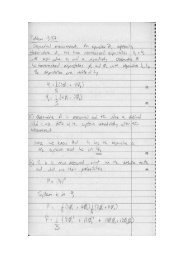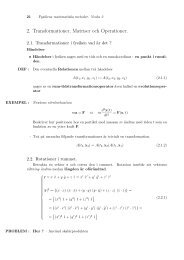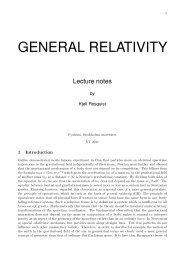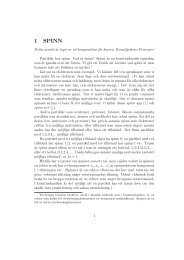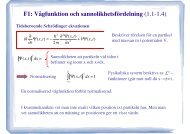Statistical Methods in Physics Part VII Bayesian Statistics, Blindness ...
Statistical Methods in Physics Part VII Bayesian Statistics, Blindness ...
Statistical Methods in Physics Part VII Bayesian Statistics, Blindness ...
Create successful ePaper yourself
Turn your PDF publications into a flip-book with our unique Google optimized e-Paper software.
✬<br />
<strong>Statistical</strong> <strong>Methods</strong> <strong>in</strong> <strong>Physics</strong><br />
✩<br />
<strong>Statistical</strong> <strong>Methods</strong> <strong>in</strong> <strong>Physics</strong><br />
<strong>Part</strong> <strong>VII</strong><br />
<strong>Bayesian</strong> <strong>Statistics</strong>,<br />
Bl<strong>in</strong>dness,<br />
and Systematic errors<br />
✫<br />
February 25, 2013 Christian Walck, SU Page 1<br />
✪<br />
✬<br />
<strong>Statistical</strong> <strong>Methods</strong> <strong>in</strong> <strong>Physics</strong><br />
✩<br />
Some extras ....<br />
Here we just want to briefly describe three statistical concepts important<br />
to know about<br />
• <strong>Bayesian</strong> statistics – very brief, Jan will hopefully f<strong>in</strong>d time to expand<br />
a bit on this.<br />
• Bl<strong>in</strong>dness<br />
• Systematic errors<br />
On the course web site I have <strong>in</strong>cluded <strong>in</strong>terest<strong>in</strong>g references on all three<br />
topics if you would like more <strong>in</strong>formation. Cowan mentions <strong>Bayesian</strong><br />
statistics on page 6 but do not seem to discuss the other two topics.<br />
✫<br />
February 25, 2013 Christian Walck, SU Page 2<br />
✪
✬<br />
<strong>Statistical</strong> <strong>Methods</strong> <strong>in</strong> <strong>Physics</strong><br />
✩<br />
BAYESIAN STATISTICS<br />
• Thomas Bayes (1702-1761) was an english matematician and a<br />
Presbyterian m<strong>in</strong>ister.<br />
• While Bayes’ theorem, which he formulated, is a simple consequence of<br />
probability theory the use of so called <strong>Bayesian</strong> statistics <strong>in</strong> other<br />
areas are very controversial.<br />
• There are a lot of “philosophical” arguments and differences which are<br />
quite <strong>in</strong>terest<strong>in</strong>g between this and the non-<strong>Bayesian</strong> (or frequentist)<br />
approach<br />
• A nice article is “Why isn’t every physicist a <strong>Bayesian</strong>?” by Robert D.<br />
Cous<strong>in</strong>s <strong>in</strong> American Journal of <strong>Physics</strong> 63 (1995) 398 (see course<br />
homepage for l<strong>in</strong>k).<br />
✫<br />
February 25, 2013 Christian Walck, SU Page 3<br />
✪<br />
✬<br />
<strong>Statistical</strong> <strong>Methods</strong> <strong>in</strong> <strong>Physics</strong><br />
Thomas Bayes (1702-1761)<br />
✩<br />
✫<br />
February 25, 2013 Christian Walck, SU Page 4<br />
✪
✬<br />
<strong>Statistical</strong> <strong>Methods</strong> <strong>in</strong> <strong>Physics</strong><br />
✩<br />
• With<strong>in</strong> the field of statistics there has been a clear division and<br />
dispute between classical (or frequentistic) statisticians and <strong>Bayesian</strong><br />
statisticians s<strong>in</strong>ce early last century.<br />
• Basically <strong>Bayesian</strong> statistics uses prior knowledge (priors) with<br />
<strong>in</strong>formation from earlier measurements/experiments.<br />
• Frequentists argue that this “degree of belief” is too subjective and<br />
hard to agree upon ...<br />
• ... while <strong>Bayesian</strong>s argue that even no prior (as a uniform distribution)<br />
is anyway an assumption.<br />
✫<br />
February 25, 2013 Christian Walck, SU Page 5<br />
✪<br />
✬<br />
<strong>Statistical</strong> <strong>Methods</strong> <strong>in</strong> <strong>Physics</strong><br />
✩<br />
• Physicists often mix, even without realiz<strong>in</strong>g, between a frequentist and<br />
a <strong>Bayesian</strong> approach. S<strong>in</strong>ce we are used to learn from past experiments<br />
one may th<strong>in</strong>k that we should be <strong>in</strong>cl<strong>in</strong>ed to be <strong>Bayesian</strong>s but often a<br />
more frequentistic approach is used (possibly mak<strong>in</strong>g it easier to<br />
comb<strong>in</strong>e different results).<br />
• However, the use of <strong>Bayesian</strong> statistics <strong>in</strong> physics has <strong>in</strong>creased <strong>in</strong><br />
popularity dur<strong>in</strong>g the last years and there are many paper and even<br />
books on the subject.<br />
✫<br />
February 25, 2013 Christian Walck, SU Page 6<br />
✪
✬<br />
<strong>Statistical</strong> <strong>Methods</strong> <strong>in</strong> <strong>Physics</strong><br />
✩<br />
Robert Cous<strong>in</strong>s on <strong>Bayesian</strong> statistics ....<br />
Reference: American Journal of <strong>Physics</strong> 63 (1995) 398<br />
✫<br />
February 25, 2013 Christian Walck, SU Page 7<br />
✪<br />
✬<br />
<strong>Statistical</strong> <strong>Methods</strong> <strong>in</strong> <strong>Physics</strong><br />
✩<br />
BLINDNESS<br />
• With<strong>in</strong> physics bl<strong>in</strong>d analysis was, at least previously, not regarded as<br />
needed <strong>in</strong> order to assure quality of results.<br />
• When hav<strong>in</strong>g clear measurements and obvious effects this may be true.<br />
On the other hand remember the comment by Ernest Rutherford “If<br />
your experiment needs statistics, you ought to have done a better<br />
experiment.”<br />
• In contrast it is well known from fields as e.g. medic<strong>in</strong>e or psychology<br />
that bl<strong>in</strong>d or even double-bl<strong>in</strong>d techniques are necessary to avoid<br />
<strong>in</strong>fluenc<strong>in</strong>g the results of a study.<br />
✫<br />
February 25, 2013 Christian Walck, SU Page 8<br />
✪
✬<br />
<strong>Statistical</strong> <strong>Methods</strong> <strong>in</strong> <strong>Physics</strong><br />
✩<br />
• Indeed also <strong>in</strong> physics one has noted that unconsciencely one easily<br />
affects results (while plac<strong>in</strong>g cuts, decid<strong>in</strong>g on remov<strong>in</strong>g “bad”<br />
measurements, hav<strong>in</strong>g an idea on what the result “should be” etc)<br />
• Or rephras<strong>in</strong>g it slightly: In a statistical analysis of experimental data<br />
samples there are substantial risks to become biased. E.g. to be guided<br />
by previous measurements, expectations or be<strong>in</strong>g biased by data itself.<br />
• It has become quite common <strong>in</strong> physics analyses to use a bl<strong>in</strong>d<br />
technique either us<strong>in</strong>g a subset for develop<strong>in</strong>g analysis methods or by<br />
scrambl<strong>in</strong>g the data set.<br />
• One should always keep <strong>in</strong> m<strong>in</strong>d that it is easy to get fooled even by<br />
ones own senses and effects are sometimes very subtle. As <strong>in</strong> the next<br />
example ...<br />
✫<br />
February 25, 2013 Christian Walck, SU Page 9<br />
✪<br />
✬<br />
<strong>Statistical</strong> <strong>Methods</strong> <strong>in</strong> <strong>Physics</strong><br />
Clever Hans (Der Kluge Hans)<br />
✩<br />
✫<br />
February 25, 2013 Christian Walck, SU Page 10<br />
✪
✬<br />
<strong>Statistical</strong> <strong>Methods</strong> <strong>in</strong> <strong>Physics</strong><br />
✩<br />
Clever Hans (contd.)<br />
• Clever Hans (der Kluge Hans <strong>in</strong> German) was a horse that was though<br />
to have special abilities. It was claimed, and demonstrated, that this<br />
horse could make arithmetic calculations and solve other even much<br />
more elaborate tasks.<br />
• When the owner would ask a question the horse answered by tapp<strong>in</strong>g<br />
his foot. Normally it would give the correct answer to everyones<br />
amazement.<br />
• This was <strong>in</strong> fact not done to fool anyone delibarately (as was shown <strong>in</strong><br />
later studies) but it was not understood how the horse could do this.<br />
✫<br />
February 25, 2013 Christian Walck, SU Page 11<br />
✪<br />
✬<br />
<strong>Statistical</strong> <strong>Methods</strong> <strong>in</strong> <strong>Physics</strong><br />
✩<br />
• A big <strong>in</strong>vestigation was <strong>in</strong>itiated <strong>in</strong> 1907 to reveal a fraud or to f<strong>in</strong>d<br />
out what was happen<strong>in</strong>g.<br />
• This was made by mak<strong>in</strong>g bl<strong>in</strong>d experiments where either the horse<br />
did not see the exam<strong>in</strong>er or none of them knew the correct answer etc.<br />
• Exchang<strong>in</strong>g the horse owner with someone else did not change the<br />
positive results show<strong>in</strong>g that it was not a deliberate fraud.<br />
• The horse got the correct answer only when the questioner knew the<br />
answer and the horse saw the questioner.<br />
✫<br />
February 25, 2013 Christian Walck, SU Page 12<br />
✪
✬<br />
<strong>Statistical</strong> <strong>Methods</strong> <strong>in</strong> <strong>Physics</strong><br />
✩<br />
• In the <strong>in</strong>vestigation <strong>in</strong> 1907 it was found that the horse actually did<br />
not solve the problems but was watch<strong>in</strong>g the human reactions.<br />
Unconsciously the owner or other observers would make a m<strong>in</strong>or<br />
gesture when the true answer was approach<strong>in</strong>g which the horse would<br />
note.<br />
• Even <strong>in</strong>form<strong>in</strong>g the exam<strong>in</strong>er that he should not do any special<br />
movement when the horse came to the correct answer did not help!<br />
• One may say that the horse was very clever but not <strong>in</strong> the sense of<br />
solv<strong>in</strong>g the problems but to note very subtle behaviour of humans!<br />
✫<br />
February 25, 2013 Christian Walck, SU Page 13<br />
✪<br />
✬<br />
<strong>Statistical</strong> <strong>Methods</strong> <strong>in</strong> <strong>Physics</strong><br />
✩<br />
• Aga<strong>in</strong>: If the horse could not see the questioner or the questioner did<br />
not know the answer it failed to deliver correct answers.<br />
• Similar th<strong>in</strong>gs may happen <strong>in</strong> many every-day situations and the<br />
example shows that one should always be sceptical to subjective<br />
observations which easily could be <strong>in</strong>terpreted as strange and fantastic.<br />
• In physics we often have much more firm measurements and it may<br />
seem unnecessary to take such precautions. However, it turns out that<br />
even physicists hade prejudices which may <strong>in</strong>fluence the results of an<br />
analysis.<br />
• This is the reason why it has become common even <strong>in</strong> physics analysis<br />
to adopt bl<strong>in</strong>d analysis.<br />
✫<br />
February 25, 2013 Christian Walck, SU Page 14<br />
✪
✬<br />
<strong>Statistical</strong> <strong>Methods</strong> <strong>in</strong> <strong>Physics</strong><br />
✩<br />
• In my experiment, us<strong>in</strong>g the neutr<strong>in</strong>o telecope IceCube at the South<br />
Pole, we always perform bl<strong>in</strong>d analysis. In some cases bl<strong>in</strong>dness may<br />
be achieved by scrambl<strong>in</strong>g (some variable <strong>in</strong>) data <strong>in</strong> other cases an<br />
analysis is optimized on a subset of the data. In the first case the full<br />
data sample may be used <strong>in</strong> the f<strong>in</strong>al analysis while <strong>in</strong> the second case<br />
we would discard the subset used to optimize the analysis.<br />
• A very nice reference describ<strong>in</strong>g many aspects of bl<strong>in</strong>d analysis is an<br />
article <strong>in</strong> Annual Review of Nuclear and <strong>Part</strong>icle Science by Joshua<br />
Kle<strong>in</strong> and Aaron Roodman from 2005.<br />
✫<br />
February 25, 2013 Christian Walck, SU Page 15<br />
✪<br />
✬<br />
<strong>Statistical</strong> <strong>Methods</strong> <strong>in</strong> <strong>Physics</strong><br />
✩<br />
Kle<strong>in</strong> & Roodman on Bl<strong>in</strong>dness<br />
✫<br />
February 25, 2013 Christian Walck, SU Page 16<br />
✪
✬<br />
<strong>Statistical</strong> <strong>Methods</strong> <strong>in</strong> <strong>Physics</strong><br />
✩<br />
Nobel Laureate Burton Richter on bl<strong>in</strong>dness...<br />
Ref: AAAS 2007, arXiv:hep-ex/0702026<br />
✫<br />
February 25, 2013 Christian Walck, SU Page 17<br />
✪<br />
✬<br />
<strong>Statistical</strong> <strong>Methods</strong> <strong>in</strong> <strong>Physics</strong><br />
The Unknown<br />
As we know,<br />
There are known knowns.<br />
There are th<strong>in</strong>gs we know we know.<br />
We also know<br />
There are known unknowns.<br />
That is to say<br />
We know there are some th<strong>in</strong>gs<br />
We do not know.<br />
But there are also unknown unknowns,<br />
The ones we don’t know<br />
We don’t know.<br />
✩<br />
(Donald Rumsfeld, Feb. 12, 2002, Department of Defense news brief<strong>in</strong>g)<br />
✫<br />
✪<br />
February 25, 2013 Christian Walck, SU Page 18
✬<br />
<strong>Statistical</strong> <strong>Methods</strong> <strong>in</strong> <strong>Physics</strong><br />
✩<br />
SYSTEMATIC ERRORS<br />
• An important consideration <strong>in</strong> all physics experiments is the<br />
understand<strong>in</strong>g and evaluat<strong>in</strong>g of systematic effects. For low statistics<br />
(i.e. small samples) experiments statistical effects will normally<br />
dom<strong>in</strong>ate but for high statistics the systematic effects will dom<strong>in</strong>ate.<br />
(Not always true!)<br />
• Intr<strong>in</strong>sically systematic errors are not well known. If we knew the<br />
effects we could correct for it and take it <strong>in</strong>to account <strong>in</strong> our analysis.<br />
Some sources may be understood and <strong>in</strong>vestigated by simulations.<br />
• Normally not easy to f<strong>in</strong>d reliable ways of evaluat<strong>in</strong>g systematic effects<br />
...<br />
✫<br />
February 25, 2013 Christian Walck, SU Page 19<br />
✪<br />
✬<br />
<strong>Statistical</strong> <strong>Methods</strong> <strong>in</strong> <strong>Physics</strong><br />
✩<br />
• Systematic effects often have unknown distributions (if one even may<br />
speak of a distribution <strong>in</strong> a unknown quantity). How much and<br />
accord<strong>in</strong>g to what distribution should we vary our <strong>in</strong>puts? Are they<br />
correlated?<br />
• A normal method is to vary parameters <strong>in</strong> a “reasonable range” and<br />
study the <strong>in</strong>fluence on the f<strong>in</strong>al result<br />
• Overcautious analysers may vary th<strong>in</strong>gs too much thereby<br />
overestimat<strong>in</strong>g their systematic errors<br />
• ... but the “unknown unknows” often leads to underestimat<strong>in</strong>g them.<br />
✫<br />
February 25, 2013 Christian Walck, SU Page 20<br />
✪
✬<br />
<strong>Statistical</strong> <strong>Methods</strong> <strong>in</strong> <strong>Physics</strong><br />
✩<br />
He<strong>in</strong>rich & Lyons on Systematic Errors<br />
Reference: Annu. Rev. Nucl. <strong>Part</strong>. Sci. 57 (2007) 145<br />
✫<br />
February 25, 2013 Christian Walck, SU Page 21<br />
✪<br />
✬<br />
<strong>Statistical</strong> <strong>Methods</strong> <strong>in</strong> <strong>Physics</strong><br />
✩<br />
A few “quotes” from the review:<br />
• The nature of systematic effects is such that they may not cause<br />
different answers when the experiment is repeated. Thus, a consistent<br />
set of results does not imply the absence of systematics.<br />
✫<br />
In general, the reliable assessment of systematics requires much more<br />
thought and work than for the correspond<strong>in</strong>g statistical error.<br />
• Some errors are clearly statistical (e.g., those associated with the<br />
read<strong>in</strong>g errors), and others are clearly systematic (e.g., the correction<br />
of a measured quantity to another reference po<strong>in</strong>t). Others could be<br />
regarded as either statistical or systematic (e.g., the uncerta<strong>in</strong>ty <strong>in</strong> the<br />
recalibration of a ruler). Our attitude is that the type assigned to a<br />
particular error is not crucial. What is important is that possible<br />
correlations with other measurements are clearly understood.<br />
February 25, 2013 Christian Walck, SU Page 22<br />
✪
✬<br />
<strong>Statistical</strong> <strong>Methods</strong> <strong>in</strong> <strong>Physics</strong><br />
✩<br />
• The result of the experiment may be quoted as x ± σ stat ± σ syst , where<br />
the statistical and systematic errors are shown separately. If a s<strong>in</strong>gle<br />
error is required, then typically σ stat and σ syst are comb<strong>in</strong>ed <strong>in</strong><br />
quadrature, on the grounds that they are uncorrelated.<br />
• At the other extreme, some or all of the systematic errors can be<br />
shown <strong>in</strong>dividually. This would be useful <strong>in</strong> comb<strong>in</strong><strong>in</strong>g different<br />
measurements, for which some of the systematic effects may be<br />
correlated between the different measurements.<br />
✫<br />
February 25, 2013 Christian Walck, SU Page 23<br />
✪


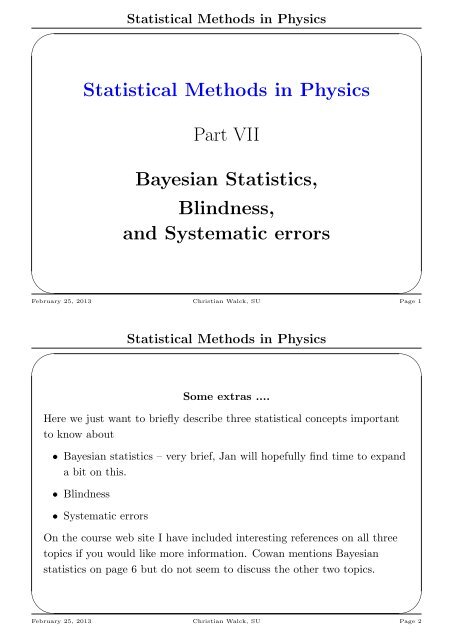
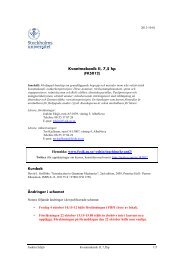
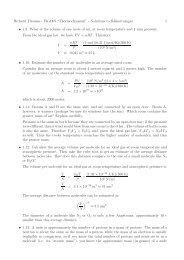
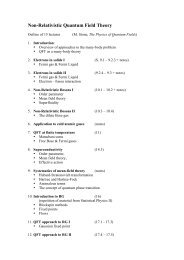
![Final Examination Paper for Electrodynamics-I [Solutions]](https://img.yumpu.com/21085948/1/184x260/final-examination-paper-for-electrodynamics-i-solutions.jpg?quality=85)

